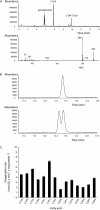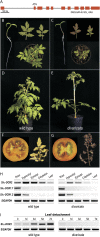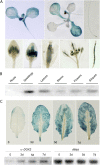Functional analysis of alpha-DOX2, an active alpha-dioxygenase critical for normal development in tomato plants
- PMID: 19759339
- PMCID: PMC2773050
- DOI: 10.1104/pp.109.145094
Functional analysis of alpha-DOX2, an active alpha-dioxygenase critical for normal development in tomato plants
Abstract
Plant alpha-dioxygenases initiate the synthesis of oxylipins by catalyzing the incorporation of molecular oxygen at the alpha-methylene carbon atom of fatty acids. Previously, alpha-DOX1 has been shown to display alpha-dioxygenase activity and to be implicated in plant defense. In this study, we investigated the function of a second alpha-dioxygenase isoform, alpha-DOX2, in tomato (Solanum lycopersicum) and Arabidopsis (Arabidopsis thaliana). Recombinant Slalpha-DOX2 and Atalpha-DOX2 proteins catalyzed the conversion of a wide range of fatty acids into 2(R)-hydroperoxy derivatives. Expression of Slalpha-DOX2 and Atalpha-DOX2 was found in seedlings and increased during senescence induced by detachment of leaves. In contrast, microbial infection, earlier known to increase the expression of alpha-DOX1, did not alter the expression of Slalpha-DOX2 or Atalpha-DOX2. The tomato mutant divaricata, characterized by early dwarfing and anthocyanin accumulation, carries a mutation at the Slalpha-DOX2 locus and was chosen for functional studies of alpha-DOX2. Transcriptional changes in such mutants showed the up-regulation of genes playing roles in lipid and phenylpropanoid metabolism, the latter being in consonance with the anthocyanin accumulation. Transgenic expression of Atalpha-DOX2 and Slalpha-DOX2 in divaricata partially complemented the compromised phenotype in mature plants and fully complemented it in seedlings, thus indicating the functional exchangeability between alpha-DOX2 from tomato and Arabidopsis. However, deletion of Atalpha-DOX2 in Arabidopsis plants did not provoke any visible phenotypic alteration indicating that the relative importance of alpha-DOX2 in plant physiology is species specific.
Figures






References
-
- Benjamin Y, Hochberg Y (1995) Controlling the false discovery rate: a practical and powerful approach to multiple testing. J R Stat Soc, B 57 289–300
-
- Bradford MM (1976) A rapid and sensitive method for the quantitation of microgram quantities of protein utilizing the principle of protein-dye binding. Anal Biochem 72 248–254 - PubMed
-
- Breitling R, Armengaud P, Amtmann A, Herzyk P (2004) Rank products: a simple, yet powerful, new method to detect differentially regulated genes in replicated microarray experiments. FEBS Lett 573 83–92 - PubMed
-
- Browse J (2005) Jasmonate: an oxylipin signal with many roles in plants. Vitam Horm 72 431–456 - PubMed
Publication types
MeSH terms
Substances
Associated data
- Actions
- Actions
LinkOut - more resources
Full Text Sources
Other Literature Sources
Molecular Biology Databases

